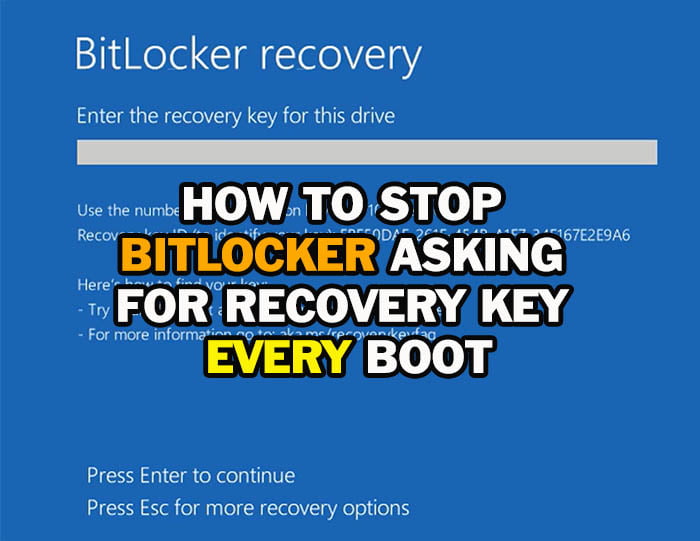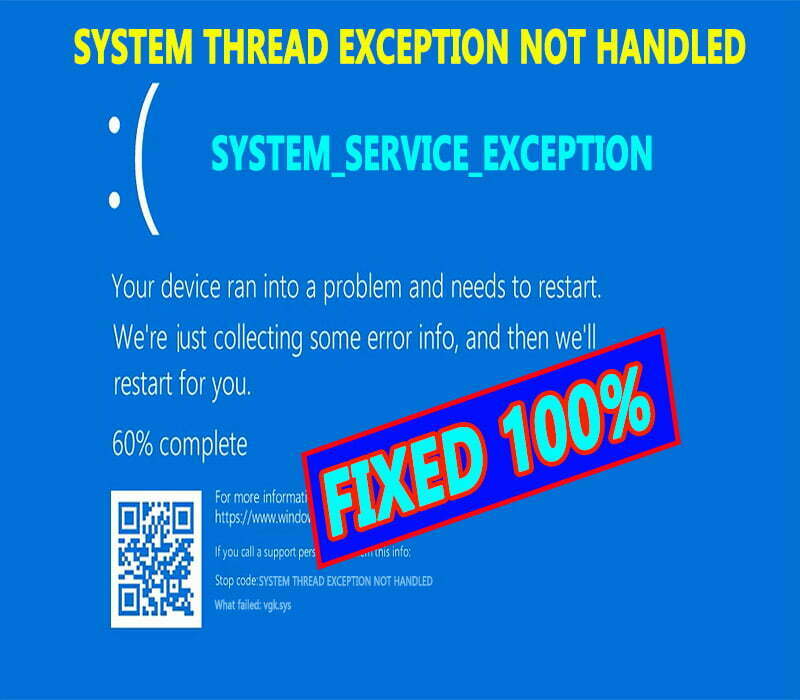How to Identify Boot, System and Recovery Partitions in Windows 10 & 11

On this topic, I will show you how to identify the boot or EFI partition in windows 10 or windows 11 and how to differentiate it from Recovery and windows partitions in both GPT and MBR systems.
Due to the similarity in sizes between boot and recovery partitions, many users may get into further problem if they mistakenly selected and formatted the recovery partition instead of Boot or EFI partition when they are trying to rebuild BCD file.
You will earn how to tell which partition is boot, and which one is the EFI partition, so you can repair BCD file in order to fix start up or boot failure without errors.
- Nomenclature:
- How to show Disks and Partitions using DISKPART from CMD?
- How to Identify Boot & Recovery Partitions?
- Differences between MBR & GPT in relation to name of Boot manager and path to BCD file:
- How to remove assigned letters from boot and recovery partitions:
- How to check which drive is windows installed on in running windows?
- How to know which partition has windows (CMD method from Advanced Recovery Environment):
- Important notes:
- VIDEO:
Nomenclature:
For illustration purpose, I will use the following names to indicates the corresponding partitions in this topic:
- Boot partition: is the partition or the volume that contains the BCD file and boot manager (Bootmgr, Bootmgfw.efi). It may called EFI, System, System reserved partition in some online sources.
- Recovery partition: Is the partition or the volume that contains Windows Recovery Image (WinRE.wim), which computer use to boot into Advanced Recovery Environment or to reset the system.
- Windows partition: Is the partition or the volume that contains the operating system and all windows files and apps. It may named the System partition in some websites.
I will show you how to identify partitions using Command Prompt from Windows Recovery Environment, however, you can do that even from running windows without booting into recovery environment.
How to show Disks and Partitions using DISKPART from CMD?
- 1. Boot into windows recovery environment.
- 2. Open command prompt.
- 3. Type DISKPART and hit Enter.
- 4. Type LIST DISK and hit Enter.
- If you see an asterisk “*” under GPT column, then your disk is GPT, And If there is no asterisk, then your disk is MBR.
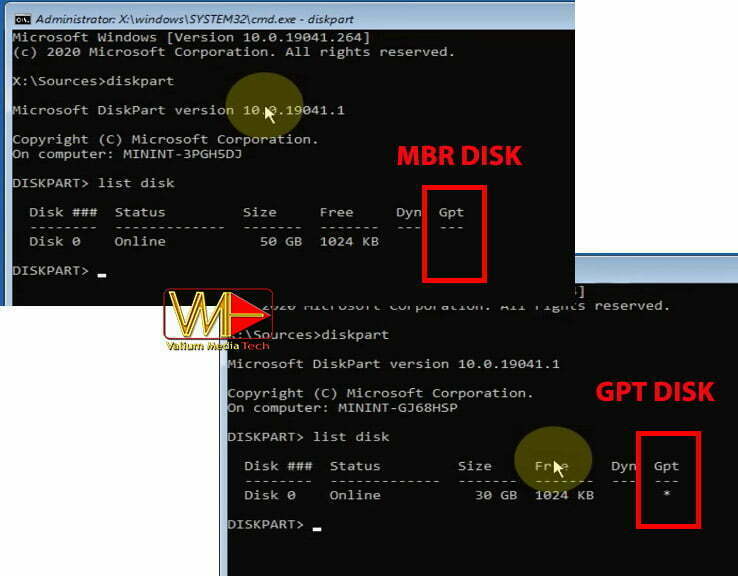
- 5. Type SEL DISK 0 to select disk that contains windows.
- 6. Type LIST VOL and hit Enter to show available volumes.
As you can see on the video, I have 2 volumes with size less than 5 megabytes with no assigned letter for both to indicates which one is the recovery and which one is the EFI or System partition.
Also, both boot and recovery partitions may have a size of 500 megabytes or less and may or may not have an assigned letter. However, your PC may come with both partitions labeled with either EFI, system or recovery to help differentiating between them. Also in rare cases, your PC may came with assigned letter for one or both partitions.
How to Identify Boot & Recovery Partitions?
To identify which one is the boot and which one is the Recovery partition, you have to assign a letter for one or both of small partitions in order to see their contents.
1. Select the partition that not have assigned letter using this command:
SEL VOL X(Replace the X with the volume number of partition without letter)
2. Type the following command to assign the V letter to the selected partition:
ASSIGN LETTER=V:3. You can assign any letter rather than V if there is no another volume have the same letter.
4. If you have another partition without assigned letter, select it using SEL VOL X command, and then assign M or any letter using ASSIGN LETTER=M command.

5. Execute “LIST VOL” command again to see if the letters assigned successfully to the selected partitions or not.
6. After assigning the letters, type EXIT to close Diskpart.
7. Execute the following command to show the files and folders inside V partition:
DIR /A /B /S V:As you will see on the video below, the V is the recovery partition in my laptop, because it contains the WINRE.WIM file which stand for Windows Recovery Environment, Windows Installation Media.

Note: If the windows recovery is disabled in your laptop, you may not see the recovery partition among other partitions, or may see “Reagent.xml” and other recovery files inside recovery partition without “WinRE.wim” file if it is shown in the volumes list.
Confirmation of Boot Partition by its contents:
To confirm that the M partition is the boot, do the follwoings:
14. Execute the following command:
DIR /A /B /S M:As you will see on the video, the M is the boot partition in my laptop because it contain the BCD files.
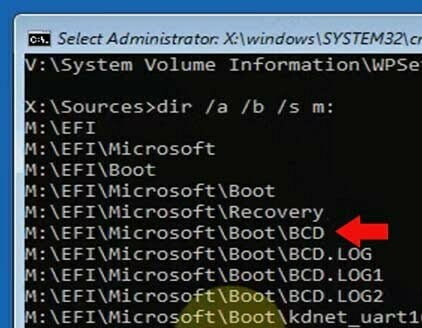
Differences between MBR & GPT in relation to name of Boot manager and path to BCD file:
There is a difference between GPT and MBR systems in the name and path of BCD file as followings:
- In Legacy or MBR-based system, the boot manager called Bootmgr and its path is X:\BOOT\BOOTMGR, and the path to BCD file is X:\BOOT\BCD
- In UEFI or GPT-based system, the boot manager called Bootmgfw.efi and its path is: X:\EFI\MICROSOFT\BOOT\BOOTMGFW.EFI, and the path to BCD file is X:\EFI\MICROSOFT\BOOT\BCD
- The X represent the letter of System or boot partition in computers with MBR disk scheme, or the EFI partition in computers with GPT disk scheme.
How to remove assigned letters from boot and recovery partitions:
- To remove assigned letters for boot or recovery partitions do the followings:
- Type DISKPART and hit Enter.
- Type LIST VOL and hit Enter.
- Select the recovery partition using this command:
SEL VOL 2(Replace “2” with the number of recovery partition in your laptop)
- Type this command to delete assigned letter:
REMOVE LETTER=V:- Select the recovery partition using this command:
SEL VOL 4- Type this command to delete assigned letter:
REMOVE LETTER=M:- Execute LIST VOL command again to see if the assigned letters removed or not.
In my laptop as you will see later on the video, the assigned letters removed successfully.
How to check which drive is windows installed on in running windows?
In running windows, you can know which partition windows is installed on from windows logo that appears on the disk in file explorer. Usually it takes the C letter, but in Advanced Recovery Environment, it may take another letter.
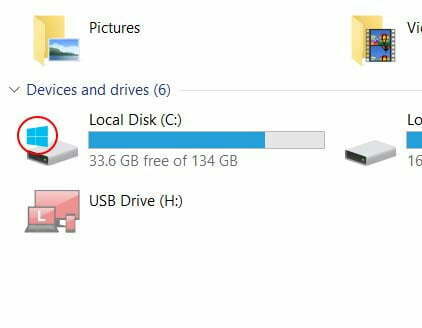
Also, you can tell which drive you are booting from in windows 10 using Disk Management tool as followings:
Right-click on Start icon and then select “Disk Management”
Expand Status column to see volumes’ details.

How to know which partition has windows (CMD method from Advanced Recovery Environment):
- Type the following command and press Enter:
BCDEDIT- From command’s result, you can know which drive contains windows files from OSDevice entry:
- As you can see, the D letter is assigned to windows partition in my laptop.
- If the BCD data not shown up after executing BCDEDIT command, do the followings:
- Type NOTEPAD and press Enter.
- Click on “File” tab and select “Open” option.
- Click on “This Computer” icon and open all partitions one by one to know which one is the windows partition.
Windows partition is the volume or partition that contains windows files and apps. Also, your installed apps are stored in folder called “Program Files”, and your account or profile is stored in another folder called Users folder. Windows, Program Files and Users folders are stored in the main directory of windows partition.
Important notes:
- Your laptop will not boot again into Windows Recovery Environment and you will not be able to reset your computer if you have mistakenly formatted recovery partition FORMAT V: /FS:FAT32 command.
- The previous formatting command is commonly used to rebuild Boot Configuration data file in order to fix blue screen boot loop issues.
- If you have formatted Windows partition, your computer will not boot into windows anymore, and you will need to install a fresh copy of windows.
That were the simple methods that can be used to know to differentiate between Boot, EFI, System, Windows or Recovery partitions. If you have another method, add it in the comments below.
If you need help about determination of boot, recovery or windows partitions, add your question in comments and I will help you.
VIDEO:
Watch this video for more details about how to identify Boot, System, and recovery partitions:
